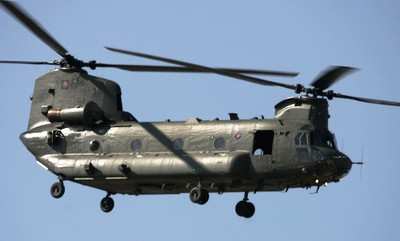New Engines And Glass Cockpits Included In The
Modifications
 RAF Chinook helicopters operating in Afghanistan will receive
a GBP408m upgrade to deliver more powerful engines and more
advanced, digitized cockpits, Minister for Defence Equipment and
Support, Quentin Davies, announced late last week.
RAF Chinook helicopters operating in Afghanistan will receive
a GBP408m upgrade to deliver more powerful engines and more
advanced, digitized cockpits, Minister for Defence Equipment and
Support, Quentin Davies, announced late last week.
Mr Davies travelled to RAF Odiham in Hampshire which is the home
of the RAF Chinook fleet to announce the upgrade and he also met
pilots and engineers involved in operating the helicopters. The
upgrade will give the whole Chinook fleet a significant boost by
fitting a more powerful engine, enabling the Chinooks to operate
more effectively in the hot summers and high altitudes of
Afghanistan.
The new modern, fuel efficient engines also mean that the fleet
will be able to fly further without refuelling and therefore spend
longer supporting the front line, before needing re-servicing. The
Chinook pilots will also benefit from improved visibility thanks to
new 'glass cockpits', which will improve their ability to fly the
aircraft under demanding low light conditions - a key feature of
operations in Afghanistan.

"The Chinook is the cornerstone of our helicopter support effort
in Afghanistan," Davies said. "These improvements will increase its
capability and ensure it can play an even more valuable role in
supporting our forces and NATO coalition allies in tackling
insurgency in Afghanistan. Upgrading the Chinook is part of a
series of improvements to our battlefield helicopter force and is
powerful evidence of our commitment and determination to give our
Forces the very best equipment."
Mr Davies was joined by Group Captain Andy Turner, Station
Commander at RAF Odiham, who explained the environmental and
operational challenges facing the Chinook in Afghanistan and how
the improvements would increase capability.
"This is an essential and very welcome step change in the UK
Chinook capability," said Turner. "It will increase the lift
capacity of our aircraft in Afghanistan, broaden safety margins
when the aircraft is heavy, reduce operating costs and equip the
aircraft through to its out of service date. We already feel
positive about what the engine will offer and I am confident that
the proven joint collaboration between RAF Odiham, the MOD
helicopter Engines Project Team and industry will deliver this
vital upgrade in record time."
Chinooks are crucial to the efforts of British forces in
Afghanistan; delivering troops, extracting casualties, supplying
Forward Operating Bases and supporting logistical efforts.

Following the loss of two RAF Chinooks in Afghanistan in August
the British fleet currently stands at a total of 36, all of which
will be upgraded with the new, more powerful engines producing 16
to 20 per cent more horsepower.
Fortunately there were no casualties in the recent Chinook loses
and Mr Davies revealed that in the second incident the helicopter
was able to continue flying and reach safety despite being badly
damaged by a Rocket Propelled Grenade (RPG). This was because the
helicopter was one of the vehicles fitted with the new engines. All
crew and passengers were then safely extracted on a second Chinook
taking part in the mission.
The Chinooks lost were replaced in theater within 72 hours,
resulting in no loss of operational capability.
Flight lieutenant Rich Elford of 27 Squadron is a Chinook pilot
who has done five operational tours in Afghanistan. "The terrain
and the climatic conditions, as well as the Taliban, all combine
together to give us enormous challenges," he said. "It makes it a
very difficult and demanding environment to work in."
The refits of both the engines and cockpits will be made as part
of the natural maintenance cycle of the aircraft, with the new
cockpits being fitted from November this year.
The cockpit enhancement program will see Boeing as the prime
contractor, working with Thales UK and Vector Aerospace, which has
long experience of Chinook maintenance and upgrade work.
 Unfortunate... ANN/SportPlane Resource Guide Adds To Cautionary Advisories
Unfortunate... ANN/SportPlane Resource Guide Adds To Cautionary Advisories ANN FAQ: Turn On Post Notifications
ANN FAQ: Turn On Post Notifications ANN's Daily Aero-Term (04.29.24): Visual Approach Slope Indicator (VASI)
ANN's Daily Aero-Term (04.29.24): Visual Approach Slope Indicator (VASI) ANN's Daily Aero-Term (04.28.24): Airport Marking Aids
ANN's Daily Aero-Term (04.28.24): Airport Marking Aids ANN's Daily Aero-Linx (04.28.24)
ANN's Daily Aero-Linx (04.28.24)





